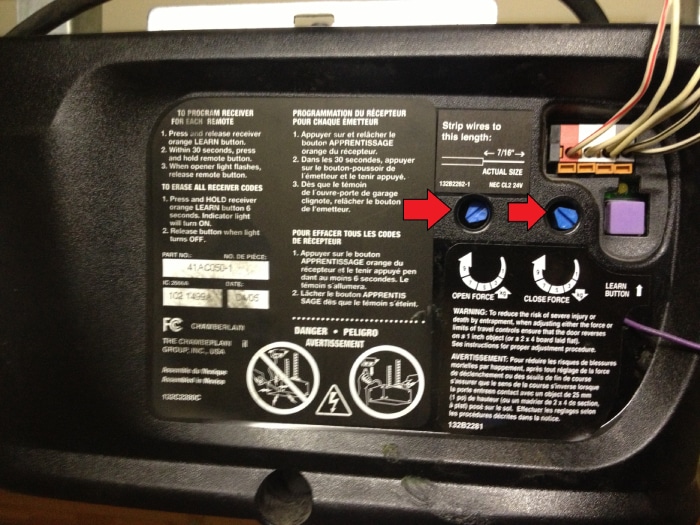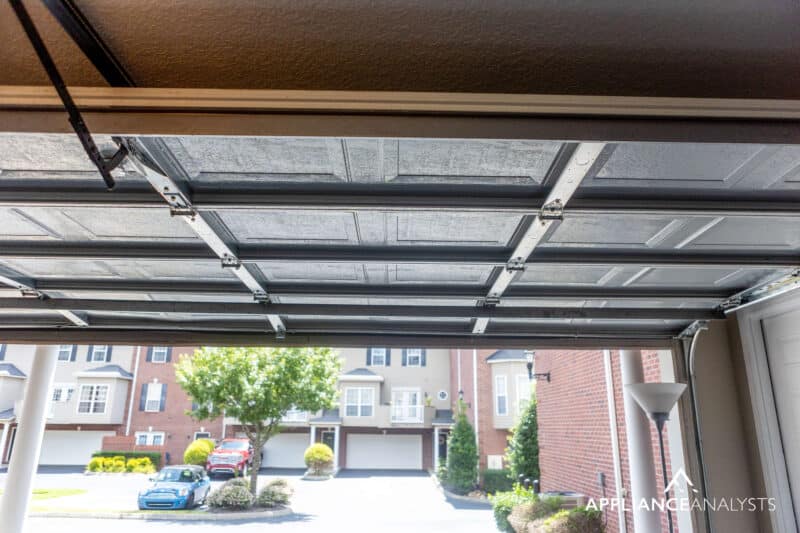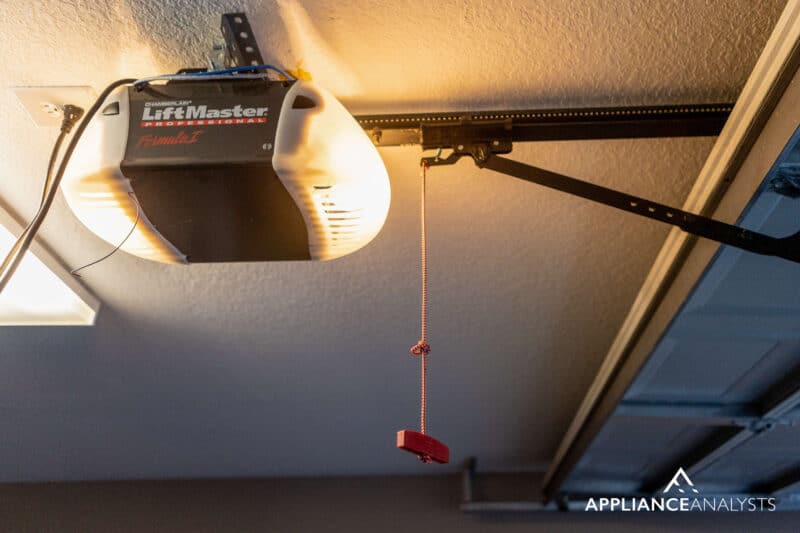Imagine this: You sit in your car, and your garage door takes its sweet time to open up. Since you’re running late, you’re irritated and frustrated.
One of the most common reasons for a garage door opening and closing slowly is that its power is set too low. Didn’t know you could adjust your garage door opener to work faster? Well, now you know.
Garage door openers output a given force onto your door. Since garage doors vary wildly in their weight, your garage door opener may simply not be set to handle the weight of your door. Thankfully, this is easy to fix.
To make sure that this doesn’t happen to you, I’ve come up with a well-researched guide on how to adjust the sensitivity and strength of any garage door opener.
If that sounds good, then let’s dive in.
Reasons Why A Garage Door Opener Might Be Running Slowly
Your garage door opener is an unsung hero. It does all the work in the background and lifts the heavy garage door to open and close, not to mention lighting the way. So, why is your garage door opener running slowly?
Garage door openers have an entire mechanism of springs, sensors, pulleys, brackets, and much more. These work together in perfect harmony to allow your door to open and shut automatically.
Typically, this mechanism doesn’t choke up. But a machine can malfunction!
One reason is lack of lubrication. When mechanical parts work together, they tend to have a lot of friction. They need to be lubricated. Since your garage door opener has to work multiple times every day, the mechanism can get a little rusty if not lubricated regularly.
If you’ve recently moved into a new house, you may find the garage door is a bit slow. This is because garage door openers are set at the lowest level, by factory default. You can fiddle with the setting and see if your garage door opens faster than before.
You can also try cleaning up the entire garage door mechanism, including its tracks and brackets. Over time, there can be a lot of dust and grime buildup, causing your garage door to work slower than usual. Let’s have a look at how you can adjust the strength and sensitivity settings to your liking.
How To Adjust The Sensitivity And Strength Of Garage Door Openers
All garage door openers have similar mechanisms and systems. There are simple instructions you can follow to adjust the sensitivity and strength levels.
Have a look at the following steps and try to follow them as directed:
Adjusting the Strength of your Garage Door Opener
In most garage door openers, you’ll find the strength labeled as ‘force’. By increasing the strength, you’ll increase the power applied to the mechanism. Thus allowing the door to open up quicker.
You’d need to climb on top of a ladder to access the garage door opener, which is installed on the ceiling of the garage.
When you get closer, you’ll notice two adjustment screws at the back: open force and close force. If your garage door opener has a slow operation on both opening and closing, then you need to tweak both screws.
Both the adjustment screws have directional stickers on them as well, which indicates what happens when you turn the screw clockwise or counterclockwise.
Normally, when you turn them clockwise, it increases the strength of the garage door opener. You can turn it up a little and then test your garage door opener.

Be careful about setting the force too high. Excessive force can cause the door to break or get damaged by hitting the floor too hard.
Also, ensure that you check the garage door on both the opening and closing functions. This will help you determine its mechanism’s health. You may want to set the closing force lower than the opening force. Doing so can help prevent any shock if/when the door connects with the ground.
Adjusting the Sensitivity of your Garage Door Opener
Another important feature is the option to adjust the sensitivity. This is a safety mechanism that comes into play if the garage door comes into contact with an obstacle while closing.
If your child or pet accidentally stands in the way when the door is closing, or you start backing up the car, the sensitivity mechanism stops the garage door immediately.
It also works in the opposite way. If the garage door is experiencing any hindrance while opening, it puts pressure on the garage door opener’s motor. The sensitivity function halts the operation instantly so the door doesn’t get damaged.
There are two different ways to adjust the sensitivity of a garage door opener:
Increasing Pressure
To increase the pressure, you have to open the door all the way. Then, locate the nut on the screw sticking out from the back of the garage door opener.
By turning it clockwise with a wrench, you’ll notice the door go up a little more, and then stop moving. At this point, turning the nut clockwise will increase the pressure of the garage door opener, thus increasing the sensitivity as well.

Adjusting the Close-Force Sensitivity
The close-force sensitivity setting is also located at the back of the unit. You can adjust it if you feel that the garage door exerts lower or higher force while closing the door. Check out the how-to video below:
Make sure to disconnect the power supply before you proceed.
The close-force sensitivity is altered by an adjustment screw at the back of the unit. If you turn it clockwise, it’ll add to the sensitivity, allowing more force on the garage door.
There are also limit adjustment screws located at the back of the garage door opener. However, they’re larger in size to help you distinguish them from the sensitivity adjustment screws.
You need to be careful while setting the sensitivity. If you set it to max, it’ll prevent the door from reversing or stopping when it hits an obstacle, which can prove extremely dangerous! Therefore, choose a moderate-level setting.
Let’s also have a look at how you can maintain the garage door and its opener.
How To Maintain A Garage Door Opener
Since your garage door is used multiple times every day, the door opener is prone to wear and tear. Therefore, it requires regular maintenance. Here is how you can ensure that your garage door opener stays in pristine condition.
Balance Test It
The balance of the door is determined by whether it can stay in place when not fully opened or closed. To perform the test, close the door completely and disconnect the chain or belt that links to the motor. Now, you can lift the door manually.
Open the door halfway and let go. It should stay in place on its own, and if it closes due to its weight, it’s time for you to call a garage door technician. Make sure to reconnect the door to the mechanism once you’re done.

Test its Reversal Ability
The reversal ability allows it to reverse its direction if it comes into contact with an object. Or to stop in between if there’s something wrong with the motor.
To do the test, you can place a small block of wood not higher than 4 inches on the ground. Place it right at the center of the point where the door meets the ground. Now, close the door and let it come into contact with the block.
If the garage door starts to open up again at this point, then this means that everything is fine. If it keeps pushing the block, then you’ll have to adjust its sensitivity and strength using the directions mentioned above.
Lubrication
Lubricating your garage door opener and its mechanism from time to time will protect it from wear and tear. Use a brake cleaner or similar liquid on the tracks of the garage door.

Don’t use lubricant here, because it can cause the door to slip off and get damaged.
For the door hinges, you can use a spray-based lubricant or grease. Also, ensure that all the screws and bolts are properly tightened and nothing is loose.
Conclusion
Your garage door is a part of your daily life. It needs attention as well. Make sure you carry out regular maintenance and get it inspected by an experienced technician at least once a year.
This way, it’ll last much longer than expected, and save you money on repairs too.
I hope this article has helped you adjust the sensitivity and strength of your garage door openers.
If you found this post helpful, make sure to check out related articles below.
Thanks a lot for reading, and have a great day!
-Craig








